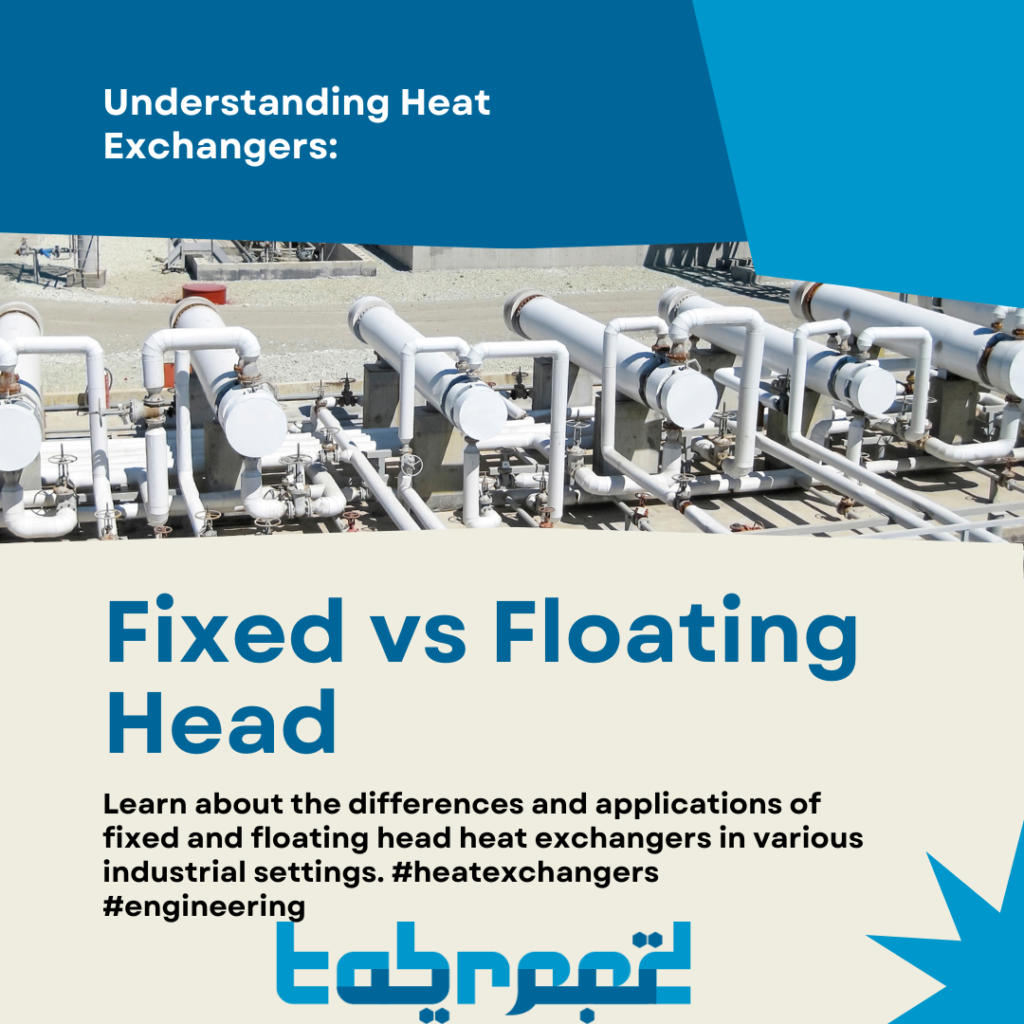Call Us 24/7
+971 55 817 1170Send Us Mail
sales@altabreed.comFixed Head Heat Exchanger Vs. Floating Head Heat Exchangers
x
Call Us 24/7
+971 55 817 1170Send Us Mail
sales@altabreed.com
Are you lost in the fixed head exchanger vs floating head heat exchangers battle? Your choice will determine how efficient your industrial application becomes. But how do you make the right choice between fixed vs floating head heat exchanger?
We will uncover the key characteristics of fixed head and floating head heat exchangers. We will also address the pros and cons of each, helping you make an informed decision. Read on to discover more.
A fixed head heat exchanger is a heat transfer device with tubes that are permanently fixed on both sides of the shell housing. The tube bundles are fixed on stationary tube sheets that are firmly welded onto the shell.
Fixed head heat exchangers are popular for their sturdy construction, simple design, and reliability. However, maintaining a fixed head heat exchanger can be difficult due to its design.
Fixed head heat exchangers have their advantages and disadvantages. Let’s take a look at a few.
Simplicity – Fixed head heat exchangers are generally simpler in design and construction. This simplicity makes them easier and less expensive to manufacture.
Stability – Since the tube sheets are rigidly connected to the shell, fixed head exchangers provide better stability and are less prone to vibrations or movement during operation.
Cost – Fixed head heat exchangers are more cost-effective to manufacture and install, resulting in lower initial costs.
Limited thermal expansion – Fixed head exchangers may experience limitations in withstanding thermal expansion of the tubes, especially in applications with large temperature differentials.
Maintenance challenges – Cleaning and maintaining a fixed head heat exchanger can be challenging. This is because the tube bundle is fixed in place, making access to the tubes more difficult.
A floating head heat exchanger is a type of shell-and-tube heat exchanger that transfers heat between two fluid streams. In a floating head heat exchanger, one of the tube sheets, typically at the front, is not rigidly connected to the shell. Instead, it is allowed to float or move within the shell.
The floating head allows for thermal expansion of the tubes without stressing the shell or other components. Floating head heat exchangers are ideal for industrial applications with large temperature variations. These types of heat exchangers are also easy to clean and maintain.
Floating head heat exchangers have their benefits and limitations. They include:
Thermal expansion – Floating head exchangers can accommodate thermal expansion and contraction of the tubes, making them suitable for applications with significant temperature variations.
Ease of maintenance – You can pull out the floating head for easier access to the tube bundle, facilitating maintenance, cleaning, and inspection.
Tube-side cleaning – Cleaning the tube bundle is easier in floating head exchangers. This can be crucial for processes with fouling or scaling issues.
Complex construction – The floating head design is more complex and may result in higher initial costs compared to fixed head heat exchangers.
Vibration and wear – The floating head design may be more susceptible to vibration and wear, especially in high-temperature or high-pressure applications.
Sealing challenges – The floating head requires sealing between the tube sheet and the shell to prevent leaks. Maintaining this seal can be a challenge.
Here are the key differences between fixed head heat exchangers and floating head heat exchangers:
The fixed head design offers stability, while the floating head design prioritizes accessibility. The choice depends on your application’s demands and the level of maintenance required.
In a fixed head heat exchanger, cleaning and maintenance pose challenges due to limited access to the tubes. On the other hand, maintaining a floating head heat exchanger is simpler since you can detach the floating head.
A fixed head heat exchanger is suitable for applications with moderate temperature and pressure conditions. In contrast, floating head heat exchangers are ideal for applications demanding high pressure and temperature conditions.
Both heat exchangers have advantages and limitations. Your choice ultimately depends on your type of application. You can consider pressure, temperature, maintenance needs, and budget considerations.
A fixed head heat exchanger can be budget-conscious but difficult to maintain. On the other hand, a floating head heat exchanger is more efficient and easy to maintain but comes at a hefty price tag. Carefully consider the pros and cons of each design to make an informed decision.
The primary difference between a floating head and a fixed head heat exchanger lies in the design of their tube bundles. In a fixed head heat exchanger, both ends of the tube bundle are permanently attached to the shell, while in a floating head heat exchanger, one end is free to move within the shell.
The floating head in a heat exchanger facilitates the expansion and contraction of the tube bundle due to temperature variations. It also makes it easy to remove and inspect the tube bundle without the need dismantling the entire exchanger.
Several industries can comfortably use both fixed and floating head heat exchangers, depending on the specific requirements of their processes. Industries that use both floating head and fixed head heat exchangers include petrochemical, power generation, chemical, pharmaceutical, and food and beverage industries.
The fixed heat exchanger vs floating head heat exchangers debate will likely continue. Each design brings its own set of advantages and disadvantages to the table. Your choice boils down to the heat exchanger that suits your application and budget. Do you still have some questions in mind? Get in touch with us today for expert insights.
Progressively maintain extensive infomediaries via extensible nich. Capitalize on low hanging fruit. a ballpark value added is activity to beta test. Override the digital divide with additional click throughs from fruit.

No products in the cart.
